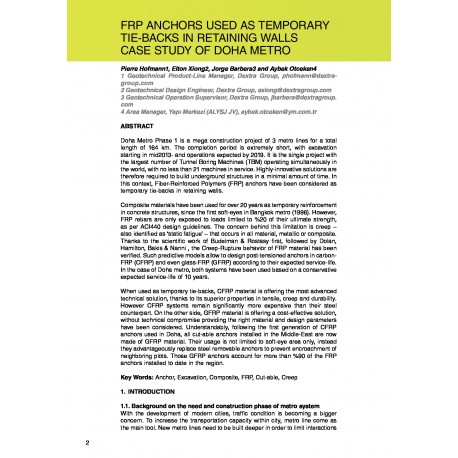Cart
0
0
No document
0,00 €
Total
Document successfully added to your shopping cart
Quantity
Total
There are 0 items in your cart.
There is 1 item in your cart.
Total documents
Total shipping
To be determined
Total
Search & filter
Search for a publication
Search & filter
Frp anchors used as temporary tie-backs in retaining walls case study of Doha metro
3017_frp_anchors_used_as_tempora
P. Hofmann / E. Xiong / J. Barbera / A. Otceken
Doha Metro Phase 1 is a mega construction project of 3 metro lines for a total length of 164 km. The completion period is extremely short, with excavation starting in mid2013- and operations expected by 2019. It is the single project with the largest number of Tunnel Boring Machines (TBM) operating simultaneously in the world, with no less than 21 machines in service. Highly-innovative solutions are therefore required to build underground structures in a minimal amount of time. In this context, Fiber-Reinforced Polymers (FRP) anchors have been considered as temporary tie-backs in retaining walls.Composite materials have been used for over 20 years as temporary reinforcement in concrete structures, since the first soft-eyes in Bangkok metro (1996). However, FRP rebars are only exposed to loads limited to %20 of their ultimate strength, as per ACI440 design guidelines. The concern behind this limitation is creep – also identified as ‘static fatigue’ – that occurs in all material, metallic or composite. Thanks to the scientific work of Budelman & Rostasy first, followed by Dolan, Hamilton, Bakis & Nanni , the Creep-Rupture behavior of FRP material has been verified. Such predictive models allow to design post-tensioned anchors in carbonFRP (CFRP) and even glass-FRP (GFRP) according to their expected service-life. In the case of Doha metro, both systems have been used based on a conservative expected service-life of 10 years.When used as temporary tie-backs, CFRP material is offering the most advanced technical solution, thanks to its superior properties in tensile, creep and durability. However CFRP systems remain significantly more expensive than their steel counterpart. On the other side, GFRP material is offering a cost-effective solution, without technical compromise providing the right material and design parameters have been considered. Understandably, following the first generation of CFRP anchors used in Doha, all cut-able anchors installed in the Middle-East are now made of GFRP material. Their usage is not limited to soft-eye area only, instead they advantageously replace steel removable anchors to prevent encroachment of neighboring plots.




